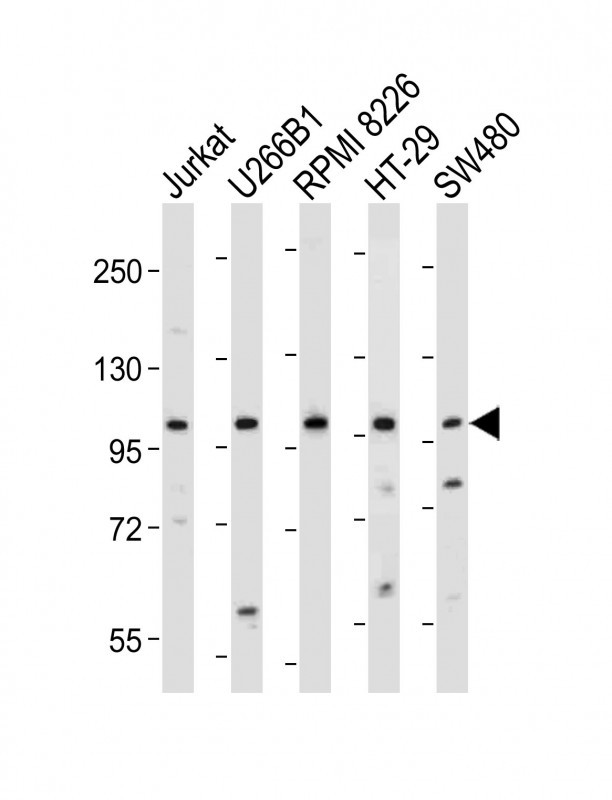NLRP6 Antibody (N-term)
Affinity Purified Rabbit Polyclonal Antibody (Pab)
- 产品详情
- 文献引用 : 2
- 实验流程
- 背景知识
Application
| WB, E |
|---|---|
| Primary Accession | P59044 |
| Other Accession | NP_612202.1 |
| Reactivity | Human |
| Host | Rabbit |
| Clonality | Polyclonal |
| Isotype | Rabbit IgG |
| Calculated MW | 98768 Da |
| Antigen Region | 168-197 aa |
| Gene ID | 171389 |
|---|---|
| Other Names | NACHT, LRR and PYD domains-containing protein 6, Angiotensin II/vasopressin receptor, PYRIN-containing APAF1-like protein 5, NLRP6, NALP6, PYPAF5 |
| Target/Specificity | This NLRP6 antibody is generated from rabbits immunized with a KLH conjugated synthetic peptide between 168-197 amino acids from the N-terminal region of human NLRP6. |
| Dilution | WB~~1:2000 E~~Use at an assay dependent concentration. |
| Format | Purified polyclonal antibody supplied in PBS with 0.09% (W/V) sodium azide. This antibody is purified through a protein A column, followed by peptide affinity purification. |
| Storage | Maintain refrigerated at 2-8°C for up to 2 weeks. For long term storage store at -20°C in small aliquots to prevent freeze-thaw cycles. |
| Precautions | NLRP6 Antibody (N-term) is for research use only and not for use in diagnostic or therapeutic procedures. |
| Name | NLRP6 {ECO:0000303|PubMed:21088234, ECO:0000312|HGNC:HGNC:22944} |
|---|---|
| Function | Acts as the sensor component of the NLRP6 inflammasome, which mediates inflammasome activation in response to various pathogen- associated signals, leading to maturation and secretion of IL1B and IL18 (PubMed:30392956, PubMed:34678144). Inflammasomes are supramolecular complexes that assemble in the cytosol in response to pathogens and other damage-associated signals and play critical roles in innate immunity and inflammation (PubMed:30674671). Acts as a recognition receptor (PRR): recognizes and binds specific pathogens and other damage-associated signals, such as lipoteichoic acid (LTA), a cell-wall component of Gram-positive bacteria, or double stranded RNA (dsRNA) (PubMed:30392956, PubMed:33377178, PubMed:34678144). May also recognize and bind lipopolysaccharide (LPS), a major component of the outer membrane of Gram-negative bacteria; however, LPS is probably not a major activator of the NLRP6 inflammasome (PubMed:31932628, PubMed:34678144). Following LTA- or dsRNA-binding, NLRP6 undergoes liquid-liquid phase separation (LLPS), enhancing multivalent interactions, an essential step for the formation of the NLRP6 inflammasome polymeric complex (PubMed:34678144). The NLRP6 inflammasome acts by promoting recruitment of effector pro-inflammatory caspases (CASP1 and/or CASP4) that catalyze maturation and secretion of IL1B and IL18 in the extracellular milieu (PubMed:12387869, PubMed:30392956, PubMed:30674671, PubMed:34678144). The NLRP6 inflammasome plays a central role in the maintenance of epithelial integrity and host defense against microbial infections in the intestine (PubMed:30392956). Required to restrict infection against Gram-positive bacteria by recognizing lipoteichoic acid (LTA), leading to recruitment of CASP4 and CASP1, and subsequent maturation and secretion of IL1B and IL18 (PubMed:30392956, PubMed:33377178). Involved in intestinal antiviral innate immunity together with DHX15: recognizes and binds viral dsRNA to restrict infection by enteric viruses through the interferon pathway and GSDMD-dependent release of IL18 (PubMed:34161762, PubMed:34678144). Required to prevent infection by the apicomplexan parasite Cryptosporidium in enterocytes by promoting GSDMD-dependent release of IL18 (By similarity). The NLRP6 inflammasome may also regulate the gut microbiota composition by acting as a sensor of microbiota-associated metabolites to form a PYCARD/ASC-dependent inflammasome for downstream IL18 release and secretion of antimicrobial peptides (By similarity). Essential for gut mucosal self-renewal and proliferation (By similarity). Regulate mucus secretion in an inflammasome- and autophagy-dependent manner to prevent invasion by enteric bacteria, (By similarity). During systemic bacterial infections, the NLRP6 inflammasome negatively regulates neutrophil recruitment and neutrophil extracellular traps (NETs) formation (By similarity). May promote peripheral nerve recovery following injury via an inflammasome-independent mechanism (By similarity). |
| Cellular Location | Cytoplasm, cytosol. Inflammasome. Cell membrane {ECO:0000250|UniProtKB:Q63035}. Nucleus membrane {ECO:0000250|UniProtKB:Q63035} |
| Tissue Location | Expressed in peripheral blood leukocytes, predominantly in granulocytes and, at lower levels, in CD4(+) and CD8(+) T-cells (PubMed:12387869). Expressed in colonic myofibroblasts (at protein level) (PubMed:21593405). |
For Research Use Only. Not For Use In Diagnostic Procedures.

Provided below are standard protocols that you may find useful for product applications.
BACKGROUND
NALPs are cytoplasmic proteins that form a subfamily within the larger CATERPILLER protein family. Most short NALPs, such as NALP6, have an N-terminal pyrin (MEFV; MIM 608107) domain (PYD), followed by a NACHT domain, a NACHT-associated domain (NAD), and a C-terminal leucine-rich repeat (LRR) region. The long NALP, NALP1 (MIM 606636), also has a C-terminal extension containing a function to find domain (FIIND) and a caspase recruitment domain (CARD). NALPs are implicated in the activation of proinflammatory caspases (e.g., CASP1; MIM 147678) via their involvement in multiprotein complexes called inflammasomes (Tschopp et al., 2003 [PubMed 12563287]).
REFERENCES
Cummings, J.R., et al. Tissue Antigens 76(1):48-56(2010)
Davila, S., et al. Genes Immun. 11(3):232-238(2010)
Albrecht, M., et al. FEBS Lett. 538 (1-3), 173-177 (2003) :
Tschopp, J., et al. Nat. Rev. Mol. Cell Biol. 4(2):95-104(2003)
Grenier, J.M., et al. FEBS Lett. 530 (1-3), 73-78 (2002) :
终于等到您。ABCEPTA(百远生物)抗体产品。
点击下方“我要评价 ”按钮提交您的反馈信息,您的反馈和评价是我们最宝贵的财富之一,
我们将在1-3个工作日内处理您的反馈信息。
如有疑问,联系:0512-88856768 tech-china@abcepta.com.






















 癌症的基本特征包括细胞增殖、血管生成、迁移、凋亡逃避机制和细胞永生等。找到癌症发生过程中这些通路的关键标记物和对应的抗体用于检测至关重要。
癌症的基本特征包括细胞增殖、血管生成、迁移、凋亡逃避机制和细胞永生等。找到癌症发生过程中这些通路的关键标记物和对应的抗体用于检测至关重要。 为您推荐一个泛素化位点预测神器——泛素化分析工具,可以为您的蛋白的泛素化位点作出预测和评分。
为您推荐一个泛素化位点预测神器——泛素化分析工具,可以为您的蛋白的泛素化位点作出预测和评分。 细胞自噬受体图形绘图工具为你的蛋白的细胞受体结合位点作出预测和评分,识别结合到自噬通路中的蛋白是非常重要的,便于让我们理解自噬在正常生理、病理过程中的作用,如发育、细胞分化、神经退化性疾病、压力条件下、感染和癌症。
细胞自噬受体图形绘图工具为你的蛋白的细胞受体结合位点作出预测和评分,识别结合到自噬通路中的蛋白是非常重要的,便于让我们理解自噬在正常生理、病理过程中的作用,如发育、细胞分化、神经退化性疾病、压力条件下、感染和癌症。






